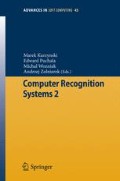Abstract
In this paper the heuristic metod based on phrase analysis is proposed for sentence boundary verification in Polish texts. The decision rules, maximum entropy and neural network as reference methods are compared with the phrase analysis. The results elaborated by the proposed method are more acurate than the reference methods.
Access this chapter
Tax calculation will be finalised at checkout
Purchases are for personal use only
Preview
Unable to display preview. Download preview PDF.
References
Krzysztof Jassem. Przetwarzanie tekstów polskich w systemie tlumaczenia automatycznego POLENG. Wydawnictwo Naukowe UAM, 2006.
Slawomir Kulików. Implementacja serwera analizy lingwistycznej dla systemu THETOS-translatora tekstu na jcezyk migowy. Studio, Informatica, 24(3 (55)):171–178, 2003.
Kelley Herndon Ford Neha Agarwal and Max Shneider. Sentence boundary detection using a maxent classifier.
David D. Palmer and Marti A. Hearst. Adaptive multilingual sentence boundary disambiguation. Computational Linguistics, 23(2):241–267, 1997.
Ross Quinlan. C4.5: Programs for Machine Learning. Morgan Kaufmann Publishers, 1993.
Adwait Ratnaparkhi. A simple introduction to maximum entropy models for natural language processing. Technical report, Institute for Research in Cognitive Science, University of Pennsylvania, 1997.
Jeffrey C. Reynar and Adwait Ratnaparkhi. A maximum entropy approach to identifying sentence boundaries. Proceedings of the Fifth Conference on Applied Natural Language Processing, pages 16–19.
E. Stamatatos, N. Fakotakis, and G. Kokkinakis. Automatic extraction of rules for sentence boundary disambiguation. Proceedings of the Workshop in Machine Learning in Human Language Technology, Advance Course on Artificial Intelligence, pages 88–92, 1999.
Nina Suszczanska, Miroslaw Forczek, and Artur Migas. Wieloetapowy analizator morfologiczny. Speech and Language Technology, 4:155–165, 2000.
Stanislaw Urbanczyk, editor. Encyklopedia jezyka polskiego. Zaklad Narodowy im. Ossolinskich — Wydawnictwo, 1991.
Daniel J. Walker, David E. Clements, Maki Darwin, and Jan W. Amtrup. Sentence boundary detection: A comparison of paradigms for improving MT quality. In MT Summit Proceedings VIII, September 2001.
Haoyi Wang and Yang Huang. Bondex — a sentence boundary detector, 2003.
Author information
Authors and Affiliations
Editor information
Editors and Affiliations
Rights and permissions
Copyright information
© 2007 Springer-Verlag Berlin Heidelberg
About this paper
Cite this paper
Siminski, K. (2007). Sentence Boundary Verification in Polish Text. In: Kurzynski, M., Puchala, E., Wozniak, M., Zolnierek, A. (eds) Computer Recognition Systems 2. Advances in Soft Computing, vol 45. Springer, Berlin, Heidelberg. https://doi.org/10.1007/978-3-540-75175-5_62
Download citation
DOI: https://doi.org/10.1007/978-3-540-75175-5_62
Publisher Name: Springer, Berlin, Heidelberg
Print ISBN: 978-3-540-75174-8
Online ISBN: 978-3-540-75175-5
eBook Packages: EngineeringEngineering (R0)

